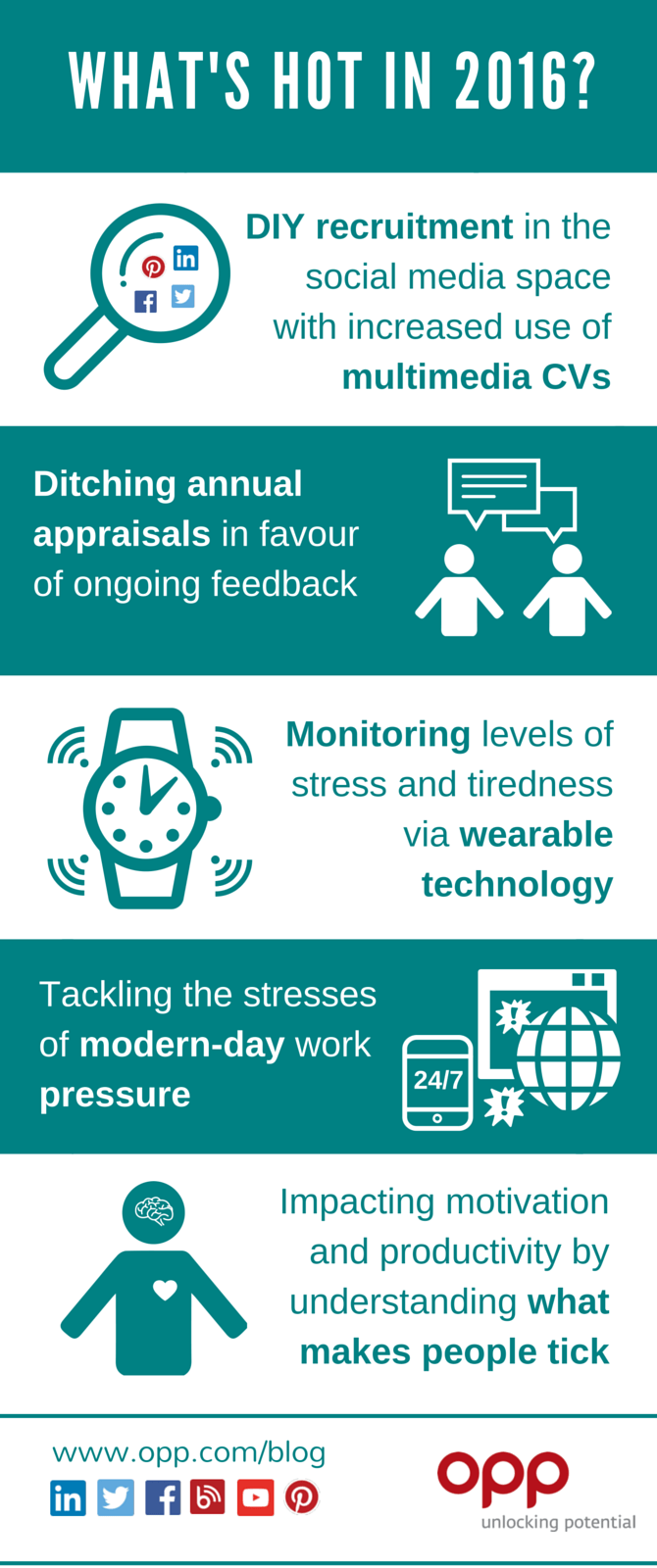What will be hot in 2016?
Posted 14 January 2016 by
Penny Moyle, CEO at OPP
Penny Moyle, CEO at OPP
Download the infographic
Candidates will abandon the standard typewritten CV in favour of multimedia, digital CVs. Examples include the LinkedIn resume with digital badges, and increased use of videos and other illustrative material relevant to candidates’ talents.
Each organisation needs to find a solution that fits them, but the general trend we’ve seen is a move away from emphasis on the formal annual appraisal. We expect that trend to increase in popularity in 2016.
While some organisations are completely dropping the annual appraisal, many are retaining it but are stopping using a single number to summarise an individual’s performance. As has always been the case, feedback throughout the year is undoubtedly more effective than saving it up for an annual roundup. With or without the annual appraisal, giving effective feedback is a skill that managers need, and the chances of making feedback stick are greatly increased when it comes from an emotionally intelligent manager who adopts a coaching management style all year around.
Related reading
Learn about the work we do with Gucci
Performance management is broken
Such monitoring could be used to prevent poor decision-making where there are associated health risks (eg lorry drivers) or financial risks, (eg financial dealers).
Related reading
Stress-free or stressful: Will tracking our stress levels really make us calm?
For the sixth consecutive year, respondents to the CIPD’s 2015 Absence Management Survey reported an increase in stress-related absence and mental ill-health in their organisation.
“Overall, two-fifths of respondents report that stress-related absence in their organisation has increased over the past year, although this rises to half of public sector organisations....Workload remains the most common cause of stress” CIPD
It’s not surprising that workload is the most common cause of stress – employees have round-the-clock access to emails and other work-enabling technology while being pressured to do more with less.
Although stress-related absence continues to rise, it’s the day-to-day chronic stresses, which mostly don’t result in absence, that have the greatest collective impact on organisations. These low to moderate levels of stress sap employee productivity and damage well-being. But the good news is there is a lot that can be done to help managers and employees manage stress. Although workload might be the most common source of stress, its impact does not need to be negative, as long as there is balance from other positive factors. Personal and environmental resources can be built to enable effective coping and create resilience.
Related reading
Stress: it is personal
CIPD Podcast – Looking ahead to 2016
A guide to building resilience
Related reading
MBTI personality Types
Five most common ways to alienate your staff

DIY recruitment in the social media space with increased use of multimedia CVs
There will be a growth in the use of social media for recruitment, leading to a decreasing dependence on recruitment agencies as more and more firms build cost-saving capability in DIY recruitment.Candidates will abandon the standard typewritten CV in favour of multimedia, digital CVs. Examples include the LinkedIn resume with digital badges, and increased use of videos and other illustrative material relevant to candidates’ talents.
Related reading
Digital badges
Facebook: career-limiting move?

Ditching annual appraisals in favour of ongoing feedback
Organisations like Google, Facebook, Netflix and Microsoft have already ditched their traditional annual appraisal systems, but is this the way to go for us all?Each organisation needs to find a solution that fits them, but the general trend we’ve seen is a move away from emphasis on the formal annual appraisal. We expect that trend to increase in popularity in 2016.
While some organisations are completely dropping the annual appraisal, many are retaining it but are stopping using a single number to summarise an individual’s performance. As has always been the case, feedback throughout the year is undoubtedly more effective than saving it up for an annual roundup. With or without the annual appraisal, giving effective feedback is a skill that managers need, and the chances of making feedback stick are greatly increased when it comes from an emotionally intelligent manager who adopts a coaching management style all year around.
Related reading
Learn about the work we do with Gucci
Performance management is broken

Monitoring levels of stress and tiredness via wearable technology
Employers will invite key employees to be monitored via wearable technology – ’wearables’ – for factors such as stress and tiredness. They will do this on the grounds that there is mutual benefit in collecting and analysing data of this nature.Such monitoring could be used to prevent poor decision-making where there are associated health risks (eg lorry drivers) or financial risks, (eg financial dealers).
Related reading
Stress-free or stressful: Will tracking our stress levels really make us calm?

Tackling the stresses of modern-day work pressure
For the sixth consecutive year, respondents to the CIPD’s 2015 Absence Management Survey reported an increase in stress-related absence and mental ill-health in their organisation.
“Overall, two-fifths of respondents report that stress-related absence in their organisation has increased over the past year, although this rises to half of public sector organisations....Workload remains the most common cause of stress” CIPD
It’s not surprising that workload is the most common cause of stress – employees have round-the-clock access to emails and other work-enabling technology while being pressured to do more with less.
Although stress-related absence continues to rise, it’s the day-to-day chronic stresses, which mostly don’t result in absence, that have the greatest collective impact on organisations. These low to moderate levels of stress sap employee productivity and damage well-being. But the good news is there is a lot that can be done to help managers and employees manage stress. Although workload might be the most common source of stress, its impact does not need to be negative, as long as there is balance from other positive factors. Personal and environmental resources can be built to enable effective coping and create resilience.
Related reading
Stress: it is personal
CIPD Podcast – Looking ahead to 2016
A guide to building resilience

Driving productivity through people
When it comes to productivity, the UK is seventh out of the G7, despite a long working hours culture. How to increase productivity while reducing workload is something of a holy grail. For a few years now, employee engagement has been heralded as the key. Then recently, I read that ‘energy is the new engagement’. Whatever you call it, at the core of any sustainable increase in organisational productivity has to be connecting with the hearts and minds of the people who run it. Understanding what makes each individual tick, and providing them opportunities to work at their full potential, would go a long way to achieving this.Related reading
MBTI personality Types
Five most common ways to alienate your staff
What are your predictions for 2016?
We'd love to know what you think so leave us a comment below.
